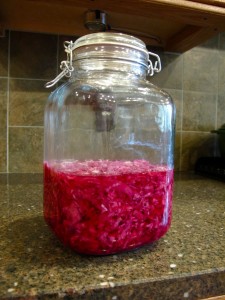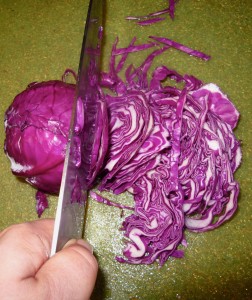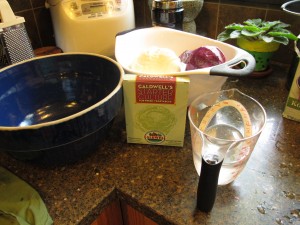Fomenting Fermentation Fun: Purple Sauerkraut
Long ago, when I was a kid, my Grandma, Grandpa, Mom, Uncle John and I made at least a hundred pounds of sauerkraut.
And no, that wasn’t even the German side of my family. That would be my Dad’s family, but oddly, he and many of his siblings despise sauerkraut and apparently never developed a taste for it.
Nope, it’s the Cherokee/Anglo-Irish/Lapsed Amish side of the family who made and ate all of that kraut.
Weird, huh?
But yeah, I remember the five of us gathering in the cold basement of Grandma’s house on a cool day in October or early November, with bushel baskets of plain old green late-season cabbages piled high around our feet, making kraut. I washed the cabbages in the sink, bobbing the heads up and down in frigid water until all traces of dirt were removed from the outside, then dried them and handed them off to Grandpa or Grandma, who would take turns shredding them using the horribly sharp kraut cutter that Grandpa had built himself.
That kraut cutter was ominous: it looked like a combination of a regular kitchen mandolin with just a whiff of guillotine added. I figure it was the rustic wood and carbon steel slanted blade that gave it a certain murderous air. And it was scary sharp. Only Grandma, Grandpa or Mom were allowed to touch the thing. And as Grandma got older, she wasn’t allowed any more.
Anyway, one would shred and the other would sprinkle the shreds into the two huge twenty gallon crocks. It was also my job to scoop a teacup of kosher salt and sprinkle it over the cabbage when directed to, sprinkling it over each crock, half a teacup in one crock, half in the other.
Mom and Uncle John had the hardest job of all–pounding the cabbage with the big, heavy wooden kraut tampers that Grandpa had turned out of oak and walnut wood on his lathe. They had a good time with it, pounding and squashing the cabbage like mad, laughing and even though it was cold downstairs, working themselves into a sweat.
I remember asking Grandma once why we never made kraut out of red cabbage, and was answered with laughter.
“Who’d want to eat purple kraut?” Grandpa said. “It wouldn’t be appetizing.”
“But kraut, when it’s been cooked with sausages isn’t very appetizing looking anyway,” I said. “But it still tastes good.”
“But being purple isn’t going to make it any better looking,” he stated and went back to making shreds of cabbage fall like snow into the deep bowl with the cutter.
Well, that’s why most folks don’t make kraut from red cabbage. Because who would want to eat purple kraut, and it’s not appetizing looking and there’s no reason in the world to make something like that.
Well, Grandpa was wrong.
Because I personally want to eat purple kraut, and it is perfectly well pretty AND it turns out to be really good for you, too.
Anthocyanins are the chemical compounds in plants that give them a blue, purple, pink or red hue. These are what give red cabbage their lovely red-violet tint, and many scientists are discovering possible health benefits for those of us who eat (or drink in the form of grape juice or especially red wine) our anthocyanins on a daily basis.
It turns out that anthocyanins are anti-oxidants, and they have properties that lower the risk of heart attack or stroke, and some of them have been found to help prevent or slow tumor growth.
Sign me up for some of that! (Note that many anthocyanin compounds are driven off or destroyed by heat, so many of these vegetables and fruits are best eaten uncooked or maybe just fermented, since acids preserve anthocyanins.)
And plus–I don’t care what Grandpa said–purple kraut is pretty and looks plenty appetizing to me–you can see for yourself in the photograph above. Seems so silly for him to say that since he loved pickled beets, but I digress.
I made this small batch of kraut with both white and red cabbage…two small heads of red and three small ones of white.
And since there was so little cabbage, I didn’t bother with the evil looking kraut cutter which resides safely high up on top of a kitchen cabinet, looking just as scary as it ever did.
Instead, I shredded it with a knife, by hand. I just cored and cut the heads in half through the stem end to the top, and then laid the half heads flat on the cutting board and then carefully sliced them into dime-thin slices. It’s easy and once you get into the rhythm, it isn’t too bad at all. In fact, it’s pretty darned good.
And it’s certainly safer than getting near Madame Guillotine, which is what I call the Grandpa’s cutter.
Since I’m the only one who eats kraut in the house now, and I was experimenting with using Caldwell’s Vegetable Fermentation Starter, I decided to not bother with dragging a crock out of the basement. I just used a glass jar with a locking gasket and lid. This wasn’t ideal, because the jar had a neck on it that is narrower at the top, just enough to make it difficult to weigh the cabbage down once it was put under the brine in the jar. I may end up finding a smaller crock and just using that.
Weighing the cabbage down once it’s in the jar is imperative, really. It keeps the kraut away from the air–air exposure is what allows molds to grow on the surface of the kraut–which, while it isn’t dangerous–can give a weird off-taste to the finished ferment. (You just scrape it off the top and toss it and eat the rest of the kraut.)
Also, kraut ferments faster in warmer weather. (That should elicit a big “duh” from the audience, but alas, it’s been a long time since I played with kraut. Though kimchi isn’t all that different and I just made a nice batch of that.)
AND, did I mention I was playing with a commercially available culture?
Yeah, I did, didn’t I?
And how did that turn out for me?
I’m still on the fence about it. I let the cabbage ferment for seven days, with the lid closed on it, but not sealed so there was still plenty of air circulation. There was no mold growing on the kraut, and there were little fermentation bubblings and fizzings here and there, but when I tasted it, it tasted saltier than I thought it should. It has a nice cabbagy flavor, but it doesn’t seem fermented enough to me.
I followed the directions on the package to the letter–and it included the use of a brine, which I had never done with kraut–instead we beat the hell out of the cabbage to make it release it’s own juices–and the flavor is okay, but saltier than I would like and not nearly as sour as I would want.
Hrm.
So, it’s back to the drawing board for me and my purple sauerkraut.
Next batch is going to be made old-school–the way Grandma did it, and if it works out, I’ll give the recipe.
Then, I’ll try this starter business once again and see if maybe this first batch was a fluke and I can get really tasty fermented cabbage from the little green box.
What’s next in my fermentation fun?
Stay tuned for cultured butter–coming soon from a kitchen near you.
6 Comments
RSS feed for comments on this post.
Sorry, the comment form is closed at this time.
Powered by WordPress. Graphics by Zak Kramer.
Design update by Daniel Trout.
Entries and comments feeds.






There’s a Lebanese takeout near my office and they have red (I understand it’s actually beet-stained) pickled cabbage as a side or, if desired, in a shawarma pita. It’s lovely, so clearly the color isn’t a problem for some people. I would definitely eat red kraut too!
Comment by Joanne — August 20, 2012 #
I’m going to be starting a kraut soon (since my experiment with kimchi turned out so well), and never thought of using a purple cabbage – you’re right, it is pretty!
Some folks who are very much into fermenting vegetables and fruits (most of them are Weston A. Price advocates) say that you should leave a ferment on the counter no less than 10 days; in some cases even longer – much longer. That makes me nervous, frankly, but I’m going to give it a whirl. I won’t be using a commercial ferment “starter” as they almost all contain whey; it’s straight salt for me.
Comment by Jan's Sushi Bar — August 21, 2012 #
Jan–when you work with salt alone, and you do a long ferment–Grandma and Grandpa’s kraut stayed in the crock for at least three weeks, often a month–be sure to keep it in a cool room. Warmth speeds up the ferment and can cause extra mold bloom on the top which is not harmful, but not great, either. And it might ick you out about making kraut again, so cool temps help.
My next batch is going to be completely salt-based, just like my kimchi.
Comment by Barbara — August 21, 2012 #
I prefer making sauerkraut with at least some red cabbage in it; for some reason, the red batches always taste better to me.
Comment by debby — August 22, 2012 #
I did a batch last year with just salt — and after a long time (couple weeks… maybe three) in a cool dark corner, it started getting nicely sour, yet stayed crunchy. Think I used the Sandor Katz book for moral support. You’re putting me in mind of doing it again… but this time with red cabbage.
Comment by Mac — August 22, 2012 #
Like I said, my next batch is going to be just salt, relying on the wild lactobacillus that is on the leaves of the cabbages and floating about in the air instead of using the culture. Though, I still have some packets of the culture of any of my in-town friends want to give it a shot.
Comment by Barbara — August 22, 2012 #